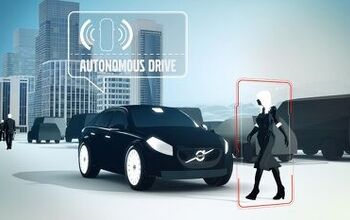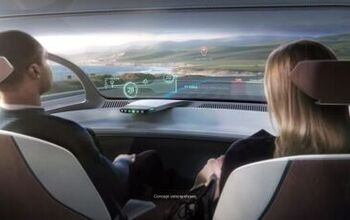QOTD: Who Should Pay for Your New Car?

As comedian and secret smart guy Norm Macdonald states during his standup routines, “Now, I don’t want to get political, but…”
Of course, Norm then trails off into a topic that’s completely removed from politics, like waiters using a sexualized tone while describing succulent desserts. I’ll keep it toned down here, lest an uproar ensues. From time to time, the actions of governments raise questions pertaining to vehicles that we can discuss without freaking out, and this happens to be one of those times.
Anyway, it turns out I’ll no longer be paying for a minute portion of someone else’s Tesla purchase.
In the corner of the world I call home, the brother of a controversial former Toronto mayor now rules the roost, and changes are happening fast. The most recent auto-related action in Ontario, which just switched parties after 15 years of Liberal dominance, saw the long-running — and gradually beefed-up — electric vehicle incentive program cancelled.
This program had nothing on the United States’ EV tax credit.
Ontario’s Electric and Hydrogen Vehicle Incentive Program, which ceased to exist on July 11th, handed over piles of cash to buyers of electric and plug-in hybrid vehicles, all in the name of citizens making the right choices, cleaner air, climate change, etc, etc. The right choice, up here, is to not drive. Even though distances are vast, airfare exorbitant, and Greyhound’s pulling up stakes across half the country, driving a car is frowned upon by politicians and activists residing mainly in three major cities with an abundance of transit options. Those people set the tone, and that sets policy. Nothing new there.
Under this program, buyers were eligible for up to $14,000 off applicable vehicles. With the incentive tied to battery capacity, Ontario buyers saw the full amount removed from the sticker of vehicles like the Tesla Model 3 Long Range, Chevrolet Bolt, Nissan Leaf, and other full-on EVs. Plug-in buyers received fewer dollars from their neighbors, though Chrysler Pacifica PHEV customers were still able to knock the full amount off the price of their Ontario-built vehicle. Chevrolet Volt buyers saw a $13,000 incentive, Volvo XC90 T8 Momentum buyers got $10,000, Mitsubishi Outlander PHEV fans got $7,000, and Toyota Prius Prime buyers collected $5,000. And so on and so forth.
The program wavered back and forth between a hefty, six-figure vehicle price cap (the top-end Tesla Model X was once eligible), and a $75,000 one, ultimately switching to the lower cap right before the recent election.
With the program scrapped (it was tied to a cap-and-trade program that’s also now defunct), EV and plug-in hybrid buyers lose a major incentive, and automakers stand to see a corresponding drop in sales in Canada’s most populous province. For low-end electrics like the Leaf, Hyundai Ioniq, and Bolt, that’s a major price hit. And automakers already sell EVs at a loss, so it’s hard to imagine an OEM replacing the full sum of the missing government incentives with its own.
Not my problem, you might say.
Call me a commie or conservative, but it always ruffled my feathers seeing well-to-do buyers (who can surely afford the full price of their virtuous automobile) accepting $14k from the inhabitants of a heavily indebted province with unresolved social issues. All while those same inhabitants, most of them unable to afford a new car — let alone an electric one — face a price increase at the pumps. (A slew of gas taxes goes towards road repair and, in cities, transit investment). EV drivers need not offer up these particular taxes, which eat up well over 40 percent of the price of a gallon of gas.
This isn’t to say I’m not a fan of plug-ins or EVs, because I am. They remain an interesting and smooth-riding alternative to our traditional, ICE-powered vehicle landscape, and the option of “refueling” at home is an attractive one. Cleaner air is always a good thing.
However, the program’s death has led to a predictable outcry — one that’s either right-on or unwarranted, depending on your stance on the importance of getting people out of their cars and into EVs as soon as possible.
If handed the levers of power, where would you draw the line when it comes to government incentives on green vehicles? Would there be a line, or would there even be a program? Maybe you’d let the market handle it, and force people who really want to drive green pay the full cost?
Surely, there’s an argument to be made that instead of giving the well-off (or at least comfortable) a break on a privately-owned vehicle with public dollars, there’s merit in using that cash for green transport everyone can use.
Weigh in below.
[Image: General Motors]

More by Steph Willems
Latest Car Reviews
Read moreLatest Product Reviews
Read moreRecent Comments
- Carrera 2014 Toyota Corolla with 192,000 miles bought new. Oil changes every 5,000 miles, 1 coolant flush, and a bunch of air filters and in cabin air filters, and wipers. On my 4th set of tires.Original brake pads ( manual transmission), original spark plugs. Nothing else...it's a Toyota. Did most of oil changes either free at Toyota or myself. Also 3 batteries.2022 Acura TLX A-Spec AWD 13,000 miles now but bought new.Two oil changes...2006 Hyundai Elantra gifted from a colleague with 318,000 when I got it, and 335,000 now. It needed some TLC. A set of cheap Chinese tires ($275), AC compressor, evaporator, expansion valve package ( $290) , two TYC headlights $120, one battery ( $95), two oil changes, air filters, Denso alternator ( $185), coolant, and labor for AC job ( $200).
- Mike-NB2 This is a mostly uninformed vote, but I'll go with the Mazda 3 too.I haven't driven a new Civic, so I can't say anything about it, but two weeks ago I had a 2023 Corolla as a rental. While I can understand why so many people buy these, I was surprised at how bad the CVT is. Many rentals I've driven have a CVT and while I know it has one and can tell, they aren't usually too bad. I'd never own a car with a CVT, but I can live with one as a rental. But the Corolla's CVT was terrible. It was like it screamed "CVT!" the whole time. On the highway with cruise control on, I could feel it adjusting to track the set speed. Passing on the highway (two-lane) was risky. The engine isn't under-powered, but the CVT makes it seem that way.A minor complaint is about the steering. It's waaaay over-assisted. At low speeds, it's like a 70s LTD with one-finger effort. Maybe that's deliberate though, given the Corolla's demographic.
- Mike-NB2 2019 Ranger - 30,000 miles / 50,000 km. Nothing but oil changes. Original tires are being replaced a week from Wednesday. (Not all that mileage is on the original A/S tires. I put dedicated winter rims/tires on it every winter.)2024 - Golf R - 1700 miles / 2800 km. Not really broken in yet. Nothing but gas in the tank.
- SaulTigh I've got a 2014 F150 with 87K on the clock and have spent exactly $4,180.77 in maintenance and repairs in that time. That's pretty hard to beat.Hard to say on my 2019 Mercedes, because I prepaid for three years of service (B,A,B) and am getting the last of those at the end of the month. Did just drop $1,700 on new Michelins for it at Tire Rack. Tires for the F150 late last year were under $700, so I'd say the Benz is roughly 2 to 3 times as pricy for anything over the Ford.I have the F150 serviced at a large independent shop, the Benz at the dealership.
- Bike Rather have a union negotiating my pay rises with inflation at the moment.


































Comments
Join the conversation
If the government really wants to promote EV usage by John/Joan Q. Public it would buy EVs for gov use. The Federal gov buys thousands of vehicles and could specify things like range. Automakers would be falling all over themselves to get those contracts. Reports had it that the Chevy Suburban was going to be phased out in the early 1980s due to high fuel prices/declining sales. It was kept alive by gov purchases for the military, FBI, etc. The USPS, now a semi gov agency, could use EV for mail delivery. The range would get longer and the price would get lower due to increased numbers. When I was at a dealership recently I looked at their PHEVs and EVs. I asked the salesman about the gov rebates and he either knew little about it or was unable to explain it. Not the best way to make a sale.
I believe Honduh and Toyoduh owners should have to pay for every domestic vehicle sold whose dollars don't end up in Tokyo. I'm all for soaking the people who tailgate the most and who abandon all common sense when behind the wheel. Tax them hundreds of thousands of dollars a year and send them into poverty.